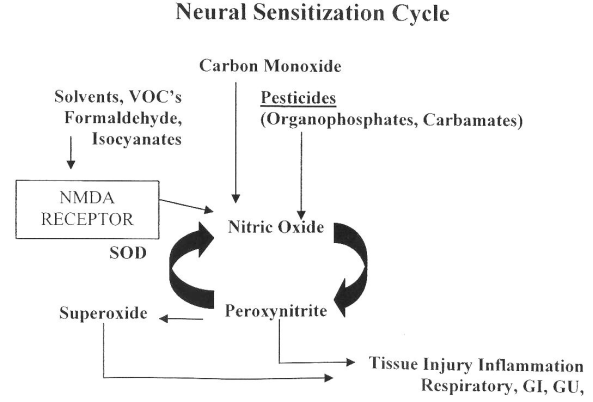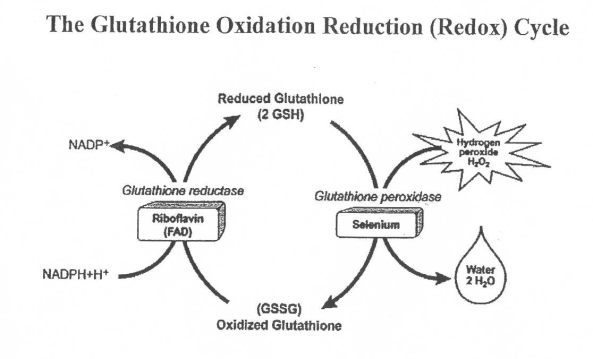

Chemically-induced reactive airway disease (upper and lower respiratory tract, and migraines have the mechanism of neural sensitization. Respiratory effects can include sinus congestion/pain; ear pain from eustachian tube blockage (swelling), burning/sore tongue and throat, hoarseness, bronchial symptoms of coughing, chest tightness and sometimes wheezing, and shortness of breath/ difficulty getting enough air. Neural sensitization also affects the gastrointestinal (sometimes called 'irritable bowel') and genital urinary tracts (sometimes called 'irritable bladder', etc.) the blood vessel linings (endothelium), conjunctiva and skin. Burning is a common sensation in neurogenic inflammation.
This widespread inflammation results in aching, fatigue, adrenal and other endocrine disturbance, and resultant depletion of amino acids, minerals and other nutrients. Inflammation and the free radicals from neural sensitization damage lipid membranes, with disproportionate damage and loss of omega 3 essential membrane lipids, because these are very vulnerable to free radical damage. This lipid damage impairs the brain and nerve cell coating (myelin). It also damages function of cell membranes and membranes of mitochondria (energy production), ribosomes (which make proteins, enzymes) DNA (genetic material), and membrane receptor sites (hormones, etc.) cell messenger sites to communicate with other cells and body organs.
The blood vessel neurogenic inflammation causes reduced blood flow, and thus reduced supply of oxygen and nutrients to body organs. The red blood cell is 7 microns, the capillary only 3 microns, so inflammation reduces the blood cell's ability to pass through. The brain is a high oxygen-demanding organ: it is only 3% of body weight but uses 20% of body oxygen at rest. Reduced blood flow in the brain in toxic encephalopathy is documented 1 and impairs brain functions, since all body functions depend on oxygen supply.
Neural sensitization can occur by activation of brain and nerve cell N-methyl-D-aspartate (NMDA), which then increases brain nitric oxide (NO). 2, 3, 4 Several vicious biochemical cycles are then set in motion. Nitric oxide forms a tissue damaging free radical known as peroxynitrite. 3, 5, 6, 7 Peroxynitrite depletes energy ATP, 8, 9 which then further increases the sensitization of NMDA. 10, 11
Peroxynitrite is a highly potent free radical that damages proteins (including enzymes), lipids (brain and, cell walls, mitochondrial membranes, ribosomal membranes and genetic DNA membranes). 12 Antioxidants such as tocopherols (natural Vitamin E), ascorbic acid (vitamin C), and glutathione help protect against these effects. 12 Cofactors for superoxide dismutase (zinc, copper and manganese) and glutathione peroxidase (selenium) can also protect against damage. 12
Neural sensitization is thus associated with self-perpetuating neuroexcitation and excessive response to further chemical exposure. 19, 13 This NMDA activation with increased nitric oxide and peroxynitrite can cause brain cell death and neurogenerative disease. 3, 7, 11, 14, 15, 16 Peroxynitrite also weakens the blood-brain barrier, allowing chemicals to enter the brain more readily. 17 Nitric oxide also damages the first detoxification step involving the cytochrome p450 system,18 allowing chemicals (and many drugs) to build up more in the body, further perpetuating the vicious chemical inflammation (neural sensitization) cycle.
Chemical exposure can induce neural sensitization.
This vicious cycle MUST therefore be interrupted to the maximum extent feasible. Because the resulting symptoms of sensitization are warnings that other more silent toxic-induced organ damage of the liver, pancreas, immune system, adrenals, mitochondria and other organs can be also occurring, 31, 32, 33 masking/blocking symptoms of this cycle is not recommended without healing the disturbed biochemical mechanism. (This would be like turning off a battery warning light without fixing the battery.)
Hydroxycobalamine (B12) is a nitric oxide scavenger and deficient in the majority of chemically ill patients. The cyano form is not recommended (these patients don't need cyanide and the hydroxy and methyl forms work much better in brain and nerve cells).
Superoxide dismutase is deficient in a significant portion of chemically ill patients and its cofactors, copper, zinc, and manganese must be adequate. These are often reduced in chemically injured patients and should be tested and replaced in well absorbed and transported forms, for example, picolinates. Antioxidant function is usually inadequate in chemically ill patients, 32 and increased lipid peroxides and other free radicals are common.
Intervention to help reduce this vicious biochemical cycle includes: hydroxycobalamine (nitric oxide scavenger) by nebulizer and nasal for rapid action in exacerbations (not oral due to poor absorption), general antioxidants (C, E, selenium), glutathione by nebulizer due to poor oral absorption, and ample alpha lipoic acid and riboflavin as cofactors to reactivate the glutathione in the many damaged lipid tissues (cell membranes, mitochondria, lymph, brain, etc.). Sublingual cobalamine is also absorbed and effective therapy, 34 although adding to nebulizer just prior to nebulizer use works faster and better.
Trimethyl glycine is recommended as a methyl donor to reduce the effects of peroxynitrite. Magnesium should be ample because deficiency is very common with toxic injury and adequate magnesium decreases NMDA activation. Peroxynitrite scavengers such as a mixture of caretenoids are also recommended. Caretenoids tend to be more organ-specific. An inclusion of gingko (brain), silimarin (liver), bilberry (collagen stabilizing, capillary permeability, vision), cranberry (urinary) and other mixed caretenoids is recommended.
Mineral levels should be measured and followed by intracellular (eg. RBC) or lipid functional (eg. lymphocyte mitogenesis, a SpectraCell technology). Functional lymphocyte evaluation and follow-up of glutathione, lipoic acid, total antioxidant function, C, E and zinc is also recommended. At this time this technology is only available through SpectraCell laboratory; http://www.spectracell.com/.
Nasal hydroxycobalamine is rapidly absorbed, well tolerated, 35, 36 and increases body levels.36 Nasal hydroxycobalamine is also effective in reducing frequency and severity of migraines, acting as a nitric oxide scavenger. 37
Alpha lipoic acid is a potent and lipophilic antioxidant, which protects lipid membranes 38 of cells, cell structures (including the energy-generating mitochondria) and myelin. 38 It has been used in Germany for decades to treat neuropathy. 39 Magnesium acts as a blocker of the NMDA nerve receptor, thus reducing neuropathic pain and its resultant inflammation. 40 Bilberry is a potent anthiocyanoside flavinoid antioxidant that reduces capillary fragility and permeability 41 and improves damaged neurologic function. 42
Glutathione is the most important intracellular antioxidant in the body. Improving levels in the mid and lower respiratory tract can help reduce respiratory responses to irritants and help to reduce the severity and duration of the patient's reactions. A nasal form of glutathione may be used for reactions that harm brain function. A glutathione nasal spray has also reduced symptoms in people with chronic rhinitis. 43 There is no blood-brain barrier between the nose and the brain. Scientific studies document that substances being breathed into the nose directly enter the brain. Glutathione can also be absorbed through the lungs (delivered to the lungs as an aerosol) and seems able to cross the blood- brain barrier. 44 It is thus effectively delivered by nebulizer, avoiding need of IV/injection use.
Nebulizer technology is developing to allow rapid efficient delivery without noticeable noise or vibration, eg AeronebGo (800-759-3038 or available at near cost through Key Pharmacy 800-878-1322 http://keynutritionrx.com/. The AeronebGo is polycarbonate: thus durable with minimal off gassing. It is small, easily portable, and has a small battery pack (eg for travel) and separate plug in for electric outlets.
None of the above is a substitute for exposure controls at home, work and/or school: places where the person spends most of their time. Humans are social beings, and these measures above gradually increase the person's ability to enjoy the company of others and use public places. When society is adequately informed and takes public health reasonable accommodation measures to reduce irritants and toxins in personal products and public places, this further promotes health and reduces sensitization.


F ollow the links below to learn more about RMEHA and Environmental Illness.